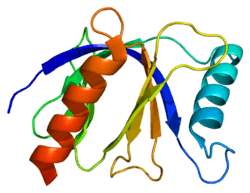EPS8L1
Epidermal growth factor receptor kinase substrate 8-like protein 1 is an enzyme that in humans is encoded by the EPS8L1 gene.[5][6]
This gene encodes a protein that is related to epidermal growth factor receptor pathway substrate 8 (EPS8), a substrate for the epidermal growth factor receptor. The function of this protein is unknown. Several alternatively spliced transcript variants encoding different isoforms exist.[6]
References
- 1 2 3 GRCh38: Ensembl release 89: ENSG00000131037 - Ensembl, May 2017
- 1 2 3 GRCm38: Ensembl release 89: ENSMUSG00000006154 - Ensembl, May 2017
- ↑ "Human PubMed Reference:".
- ↑ "Mouse PubMed Reference:".
- ↑ Tocchetti A, Confalonieri S, Scita G, Di Fiore PP, Betsholtz C (Mar 2003). "In silico analysis of the EPS8 gene family: genomic organization, expression profile, and protein structure". Genomics. 81 (2): 234–44. doi:10.1016/S0888-7543(03)00002-8. PMID 12620401.
- 1 2 "Entrez Gene: EPS8L1 EPS8-like 1".
Further reading
- Kimura K, Wakamatsu A, Suzuki Y, et al. (2006). "Diversification of transcriptional modulation: Large-scale identification and characterization of putative alternative promoters of human genes". Genome Res. 16 (1): 55–65. doi:10.1101/gr.4039406. PMC 1356129. PMID 16344560.
- Wan D, Gong Y, Qin W, et al. (2004). "Large-scale cDNA transfection screening for genes related to cancer development and progression". Proc. Natl. Acad. Sci. U.S.A. 101 (44): 15724–9. doi:10.1073/pnas.0404089101. PMC 524842. PMID 15498874.
- Gerhard DS, Wagner L, Feingold EA, et al. (2004). "The Status, Quality, and Expansion of the NIH Full-Length cDNA Project: The Mammalian Gene Collection (MGC)". Genome Res. 14 (10B): 2121–7. doi:10.1101/gr.2596504. PMC 528928. PMID 15489334.
- Ota T, Suzuki Y, Nishikawa T, et al. (2004). "Complete sequencing and characterization of 21,243 full-length human cDNAs". Nat. Genet. 36 (1): 40–5. doi:10.1038/ng1285. PMID 14702039.
- Offenhäuser N, Borgonovo A, Disanza A, et al. (2004). "The eps8 Family of Proteins Links Growth Factor Stimulation to Actin Reorganization Generating Functional Redundancy in the Ras/Rac Pathway". Mol. Biol. Cell. 15 (1): 91–8. doi:10.1091/mbc.E03-06-0427. PMC 307530. PMID 14565974.
- Strausberg RL, Feingold EA, Grouse LH, et al. (2003). "Generation and initial analysis of more than 15,000 full-length human and mouse cDNA sequences". Proc. Natl. Acad. Sci. U.S.A. 99 (26): 16899–903. doi:10.1073/pnas.242603899. PMC 139241. PMID 12477932.
- Wu K, Xu Z, Wang M, et al. (1999). "[Cloning and expression analyses of down-regulated cDNA C6-2A in human esophageal cancer]". Zhonghua Yi Xue Yi Chuan Xue Za Zhi. 16 (5): 325–7. PMID 10514543.
This article is issued from
Wikipedia.
The text is licensed under Creative Commons - Attribution - Sharealike.
Additional terms may apply for the media files.









